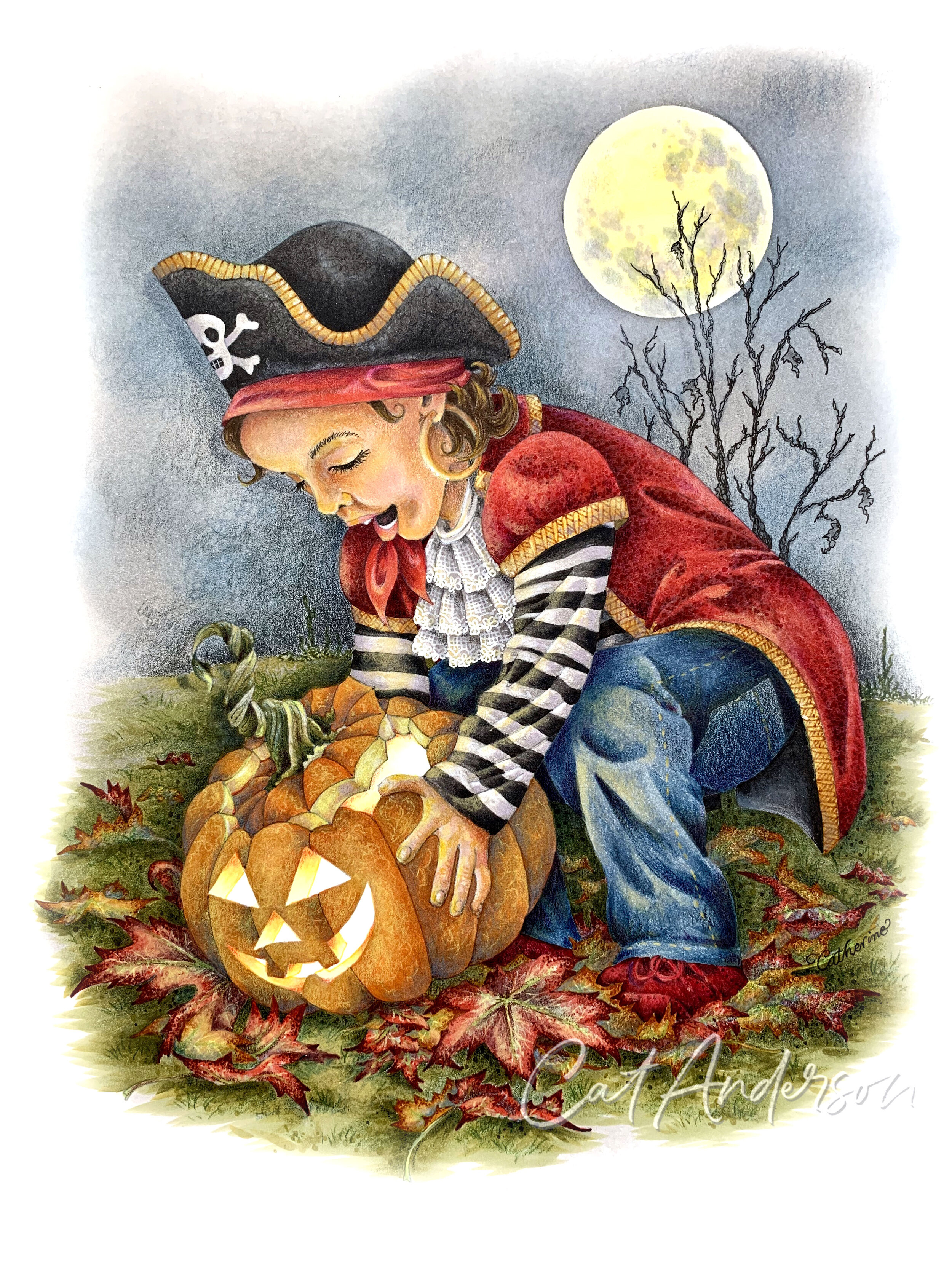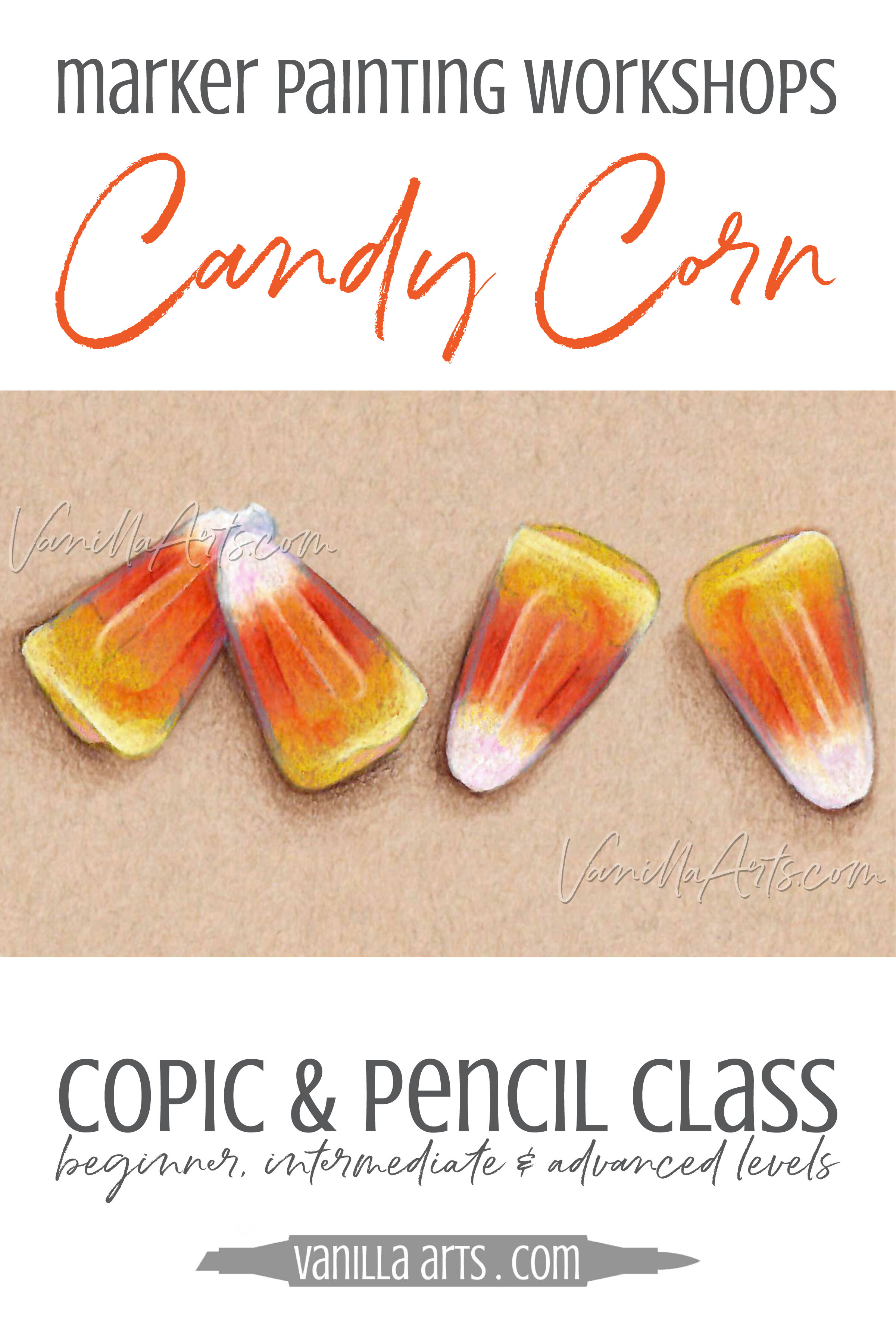Coloring Critiques: The importance of Project Feedback (Copic Marker & Colored Pencil)
by Catherine Anderson
Critiques - the Critical Key to Artistic Growth
“I’ve never posted my artwork before and I’m pretty nervous…”
Does the thought of posting your Copic Marker projects for critique make you squeamish? Are you nervous about submitting your colored pencil classwork for feedback? Are you afraid of sharing anything you draw or color for fear of someone laughing?
Coloring friends, you have NOTHING to be afraid of.
Critiques supercharge artistic growth!
“The Pirate & The Pumpkin”, an original Copic marker and colored pencil portrait by Catherine Anderson
Do you want to learn how to use your Copic markers and colored pencils above and beyond normal expectations?
Is amazing artistry worth stepping out of your comfort zone?
After 15 failed attempts trying to get a smooth blend on your gingko leaves class project, are you ready to scream?
Why are you waiting so long to ask for help?
Posting your work-in-progress allows Amy and the Vanilla Arts team to give you some excellent advice for improvement while it can still make a difference.
Often the solution to your artistic dilemma is as simple as, “If you go slower with the YG03, you’ll get more ink down for a great blend.”
Ta-da! 90% of all gingko leaf blending problems are solved right there!
Now that didn’t hurt too much, did it?
Join us for today’s Inkwell to discover why critiques are crucial.
Remember, here at Vanilla Arts, you are learning amongst friends, so don’t be intimidated. There’s nothing that friends want more than to see each other succeed!
It's time to take it to the next level and Catherine’s here to hold you hand…
Better thinking for better inking!
Inkwell No. 3: Building Up, NOT Tearing Down
“Critiques…”
It’s a misunderstood word that strikes terror into the heart of every new art student.
It’s actually not that scary once you understand
what a good critique is
what a good critique isn’t
and why trained artists find critiques absolutely indispensable!
It’s pretty easy to see why people cringe at this word. It is uncomfortably close to the word, “criticize.” But there is a HUGE difference:
When somebody criticizes you, the aim is to tear you down.
A good critique celebrates your strengths and strengthens your weaknesses.
Now you may be sweating it out, wondering if you even need to post your projects online for critique. After all, isn’t it enough to simply take the classes and keep your projects to yourself?
Well, that depends on how good you want to get.
Are you satisfied with basic artistic knowledge, or do you want to take it to the next level… and beyond?
After excellent instruction and practice, nothing will help you advance further and faster than critiques!
The Limit of Demonstrations
The type of classes you take are a good indication of your artistic aspirations.
YouTube is an amazing information resource for anything and everything— from roasting a turkey to coloring with Copics.
These videos are produced by people with varied amounts of skill…some incredible and some not so much.
Art instruction on YouTube is free but folks, there’s a price. It’s not a real class.
Even some of the online classes, and yes, they call themselves CLASSES are really nothing more than demonstrations.
If it doesn’t involve two way communication between teacher and student, it’s not a class.
Friends, you get what you pay for!
Real art classes offer feedback, advice, and critiques.
Professional artists and art instructors know this. The way to learn and grow is to focus on the areas where we need to learn and grow. We can’t always see our own artwork the way the world does. This why feedback is the cornerstone of Workshops from Vanilla Arts Co.
When I decided to get involved with Copic coloring, I knew it was going to be an investment.
These aren’t dollar store markers; they are top-of-the-line professional tools, worthy of top-of-the-line professional advice!
The promise of feedback and support is why I chose to study with Vanilla Arts Co.
But no matter what kind of a marker virtuoso Amy Shulke is and no matter how talented her team is, they can’t diagnose problem areas and help you get better if you never share your work.
Critiques are an invaluable opportunity to share ideas with a trained artist, develop a keener eye for aesthetics, nip problems in the bud, and make your artwork stand out in a crowd!
A well thought-out critique takes a lot of time and tact. Appreciate anyone who cares enough to closely examine your artwork. Those are the people who care enough to see you reach your full potential!
Good Feedback versus Careless Commentary
There’s a big difference between a good critique and cutting criticism.
When I was twelve, I created a pen and ink rendition of a black Arabian stallion. Oh my goodness, I was so excited! Never in my life had I drawn anything so beautiful.
My father was almost as impressed as I was. So when his friend *Tim (*name changed to protect the guilty) popped over for a visit, Dad proudly nudged me to bring out the drawing.
Hmm-m. You’ve drawn the horse’s body too long. And look at his rump…it shouldn’t be so deep. Makes his hind legs too short.
I can still remember how deeply his thoughtless words cut.
There wasn’t a single good thing that Tim had to say about my drawing. Everything he said was true, but he never mentioned the good stuff. All he did was pick on the flaws and suddenly, flaws were all I could see. I stuffed the paper into my drawer and never liked it…or Tim…again!
What a Good Critique Is:
First of all, a critique can not come unsolicited.
Sometimes we want advice and assistance, but other times all we need is a pat on the back. So there’s a big difference between Tim’s criticism and real critique.
What else makes for a positive feedback experience (even when the news is negative)?
A good critique admires successes first, then diagnoses problems and brainstorms for solutions.
A good critique considers what the artist is trying to accomplish and whether or not they achieved their objective.
Comments should be constructive and truthful, but not so harsh that the student is left feeling humiliated and ready to give up.
What a Good Critique Is Not:
As I said before, critiques don’t come flying at you out of the blue. Good advice is only helpful if you’re ready to hear it. So if you didn’t ask for the evaluation, then it’s nothing more than rude criticism.
Turning a blind eye to areas that need improvement isn’t a good critique. False praise is more detrimental than honest correction.
A good critique does not cause embarrassment. Professional instructors are there to help you, not belittle you.
But at the same time, if an honest and helpful critique is ethically offered in a classroom setting and you walk away with a grudge or hurt feelings, the problem may be on your end. Don’t let all those Dove moisturizing commercials fool you…sometimes it’s important to have tough skin!
A good critique does not leave you floundering aimlessly with problems that you don’t know how to fix. Instead, it gives you renewed energy and a direction to follow.
And here’s another point to consider: your critique may not be the same as another student taking the same class at the same level.
Because good critiques are tailored to the art student, you can’t look at someone else’s project critique and say “Hmmm, they colored the pirate hat badly, why didn’t the teacher point that out?” A good instructor knows what each student is working on and challenges each student to rise at their own pace. So while you can learn from reading other critiques, you have to keep in mind that it wasn’t written for you.
Why Artists Learn to Love Critiques:
If art is your passion, then you want to reach your full potential!
This requires being teachable.
After all, if you already know everything, why bother taking a class?
You will quickly realize the shortcomings of critiques that only “rah-rah” triumphs and ignore trouble areas.
Without any higher goals to reach, artists become creatively lazy. Their artwork grows stagnant.
I don’t consider a critique of my work to be useful unless it includes some, “What if next time you tried…”
There’s also something odd about good critiques— the more you receive, the more you crave them.
Amy laughs about her first critique session; she went through an entire roll of Tums just leading up to the first sketch critique. But she actually left smiling. The instructor admired something she hadn’t even noticed in her project. Then he told her how to fix something she’d struggled with for hours. By the end of the semester, she would have scheduled a critique for every day if she could. Not only do they save you time and frustration, but they also give you a positive sense of purpose.
8 Tips for Giving Critiques:
1. NEVER GIVE UNSOLICITED ADVICE!
A critique is only positive if the artist wants to hear what you think. Even after years of receiving and giving critiques, Amy still hesitates to offer advice outside of the classroom setting. Most of the time, people really only want you to compliment their work and exchange brief pleasantries. Offering to tell someone everything they’ve done wrong is a great way to ruin a friendship.
And by the way, “what do you think?” is not the same as “what do you see here and what would you do differently?”
2. Don’t give a critique if you are tired or grumpy.
You will either not bother to examine the artwork closely enough, or you will run the risk of being harsher than necessary.
3. Follow the sandwich method: always begin and end your comments with something positive.
To quote the famous philosopher…Mary Poppins…”A spoonful of sugar helps the medicine go down!”
4. Keep your audience in mind…
Is this artwork done by a child? Don’t discourage their artistic interest by expecting adult capabilities. Be generous with praise and stingy with negatives.
Is the person a hobbyist, coloring merely for relaxation and pleasure? If they’re pleased with their project, then they’ve already succeeded. Keep suggestions minimal.
Is the person passionate about being a good artist? You can share more freely with them BUT ONLY if they’ve asked!
And by the way, do tread lightly when offering critique to someone who is more skilled than you are. If you’re only two weeks into an introductory drawing course, that might not be the best time for you to offer drawing advice to a professional artist with years of experience.
5. Be humble in your approach
Ultimately, a critique is nothing more than your opinion. You are sharing with someone what you see… but it’s just your viewpoint. The student can take your advice or not. They are not obligated to value your insight or act upon it.
6. Don’t state problems without solutions.
By giving reasons for why something isn’t working, the student will learn to think like an artist. Likewise, when giving a compliment, explain why that area was successful.
7. Focus on major issues.
Nit-picking every detail is disheartening. Limit your comments to the top 2 or 3 problems. Once the person is making strides in those areas, they will have more artistic confidence to tackle other issues.
8. Consider the setting and circumstances.
If artwork has been published or put into production, it is no longer open to constructive critique. This includes YouTube videos, Instagram pics, Facebook posts, or even art fairs or art shows. Critiques are done when the work is in progress, not after it’s too late to do anything about it.
7 Tips for Taking Critique:
1. Be teachable.
If you only want to hear what you did right, don’t ask for a critique. But remember, if you only ask for high-fives, you are severely stunting your artistic growth.
2. Don’t expect professional critiques from family members.
Love and even friendship complicate the critique process. Some people will only offer glowing reviews for even the worst looking work because they love you. Conversely, close family members may be hard to impress because they’ve seen all your work.
But also consider that friends and family usually are not artists or even aware of your goals. They also do not understand the process or techniques involved. It’s unfair to put loved ones in the position of critiquing your work.
3. Stop expecting perfection.
Art is a continual stretching of creativity. If it were possible to reach perfection, then it's time to find a new hobby that challenges you!
4. Remember that much of art is subjective.
Glean whatever kernels of good advice you can, and then blow away the chaff. Impressionism would not exist today had Monet allowed himself to be discouraged by his art critics!
5. Don’t take it personally.
Critiques aren’t about you; they are about your art. Until you can separate the two, it’s unfair to ask someone to give you an evaluation.
If you react badly, nobody will want to give you advice— especially not honest advice. It’s easier just to let you carry on, blissfully ignorant of what improvements could be made, than to put up with a tantrum. Don’t let pride make your artwork less than what it could be!
6. Ask questions.
Often what you hear is not exactly what the person meant. Asking questions opens the door to further exploration of the topic. You’ll learn more from a conversation than a lecture.
7. Learn from other people’s mistakes.
Read comments made on other similar projects. This will give you additional insight into what works and what doesn’t. But always keep in mind that you were not the intended audience and your circumstances are very likely different.
Remember:
Good movies need directing.
Good novels need editing.
Good art needs critiquing!
You’ve got this, coloring friends!
Until next time, HAPPY INKING!
Catherine
Seeking a Muse?
Are you wondering where Catherine got the inspiration for her drawing, “The Pirate & The Pumpkin?” Check out Amy Shulke’s fabulous fall-themed workshops, “Baby Pumpkin” and “Rustic Maple Leaf,” as well as her blog article, “How to Create a Spooky Mood and a Realistic Glow.”
Start applying what you learn in Amy’s workshops to your own art. You will be astonished at how your confidence, creativity and personal artistic style begin to emerge!
Catherine Anderson is a graphic designer who is fearless in her use of color and detail.
She is originally from Prince Edward Island, Canada but to our knowledge, Catherine has never broken a slate over anyone’s head. Just to be safe, don’t yank on her braids.
Select Baby Pumpkin Supplies:
Vanilla Arts Company is a participant in the Amazon Services LLC Associates Program, an affiliate advertising program designed to provide a means for use to earn fees by linking to Amazon.com.
















